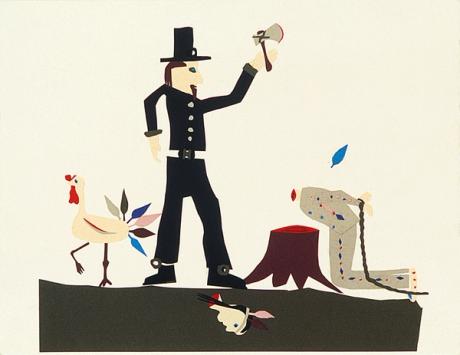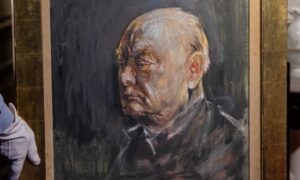[ad_1]

Artist Doug Argue is calling the Weisman Art Museum’s (WAM) refusal to sell a monograph on his art in its bookstore during his recent survey exhibition there a form of “book banning”.The exhibition, held last summer at the University of Minnesota museum, featured work Argue made since the early 1980s. Argue’s work has been shown at One World Trade Center and the Venice Biennale. He’s best known in Minnesota for his giant painting of a factory chicken coop, on view for many years at WAM.One work originally selected by guest curator Elizabeth Armstrong for the show, Doug Argue: Letters to the Future (17 June-10 September 2023), depicting a boy with an electrical cord around his neck, was “censored”, according to Argue. “They said if somebody saw it they might commit suicide,” he said at a lecture at the Minneapolis Institute of Art in January. Argue drew inspiration from Rembrandt’s Lucretia (1666) and his brother’s death in a car accident for the work.Doug Argue, Untitled, 1983 Courtesy the artist“We make decisions every day about how an exhibition is put together,” WAM’s director Alejandra Peña-Gutiérrez wrote in response to questions about Argue’s show. “Those choices are driven by practical concerns— financial constraints, shipping logistics, space considerations in the gallery—as well as curatorial choices.”Though it has the same title as the show—Doug Argue: Letters to the Future (2020)—the catalogue was produced independently by Skira. Argue says he learned it wouldn’t be sold at the bookstore the day after the exhibition opening from the book’s editor, Claude Peck. Then Peña-Gutiérrez called him. “It was a really brief conversation,” Argue says.“All she said was, ‘the conquistador’.”Several works reproduced in the catalogue, all made in 1990, present Europeans mutilating, caging and beheading Indigenous figures. Another painting in the catalogue, Hanging (1989), depicts hooded figures hanging from gallows.“My piece was about the education I got, and how it was whitewashed,” Argue says. “It’s not like I’m taking somebody’s history. I’m taking my own history, and I’m sort of protesting about the fact that we didn’t learn any of those things when I was in school.”Doug Argue, Chickens, 1994 Armenian Museum of Contemporary Art, courtesy the artistAccording to Peck, the idea arose while he was working on the book to have a companion show of Argue’s work at WAM. Late in the process, former WAM director Lyndel King wrote a foreword for the book. In 2020, King retired, then the show was postponed due to Covid-19. Peña-Gutiérrez became director in 2021. After the opening, Argue says the copies of the catalogue he had signed at WAM were sent to the Cafesjian Art Trust in Shoreview, Minnesota.“We didn’t have a problem with the original title of the exhibition, and I saw no issue with keeping it when the show was finally presented last summer,” Peña-Gutiérrez wrote.The book’s content was another matter. “Arts organisations like ours must be accountable to their communities for the decisions they make,” Peña-Gutiérrez wrote. “There are several artwork images in the artist’s book that are culturally insensitive and presented without context. While the artist holds responsibility for their creative choices, I have a responsibility to ensure what the Weisman puts its support behind aligns with our values.”Doug Argue, Untitled (Bar Scene), 1987. Collection of Weisman Art Museum. Image courtesy of Weisman Art MuseumThe conflict over Argue’s work illuminates the challenges museums face as they try to become more inclusive while also navigating an increasingly politicised climate around campus freedom of speech and the ways American history is told. That process is not linear, according to Kelli Morgan, director of curatorial studies at Tufts University, who works with museums on anti-racist initiatives.The moment of change brought by the Covid-19 pandemic and the murders of George Floyd and Breonna Taylor in 2020 “really demonstrated that the systems themselves have to change, and in order for that to happen, white people, particularly white Americans, are going to have to sacrifice”, Morgan says.Even before 2020, controversies arose around white artists creating work about historical atrocities against Black and Indigenous communities. “There’s a white privilege that assumes knowledge, and not just assumes knowledge in terms of knowing, but actually knowing better,” Morgan says. “I have access to this thing that I can speak on, even though I have no literal, or even figurative relationship to it, or knowledge about it. “Doug Argue, Fish School 2, 2021. Courtesy of the artist.Museums have been at the centre of these debates in recent years, including the Walker Art Center’s decision in 2017 to remove Sam Durant’s Scaffold (2012) from the Minneapolis Sculpture Garden, and calls for the Whitney Museum of American Art to remove Dana Schultz’s painting of Emmett Till’s mutilated body from the 2017 Whitney Biennial. More recently, the Philip Guston retrospective that just ended its run at Tate Modern was postponed due to concerns about his paintings depicting Ku Klux Klan members.Aaron Terr, director of public advocacy for the Foundation for Individual Rights and Expression, says Argue’s case might not necessarily be a violation of the First Amendment. “But the motivating factor behind the removal you can certainly say is at odds with the basic mission and purpose of a public museum,” Terr says. “A museum should stand against the idea that some art needs to be shielded from public view because it’s inappropriate.”“Was it censorship? I don’t know,” says Peck. “I don’t want to argue the semantics. To me, the book was effectively banned.”Curator Elizabeth Armstrong wrote in a statement that she wasn’t consulted about the catalogue’s removal from the bookstore, and the action prevented visitors from experiencing the wider range of Argue’s oeuvre. “A reflexive fear of people’s reactions, and a rise in censorship and cancel-culture in these bastions of learning, is a disturbing trend,” she wrote. “It undermines the opportunity and obligation museums have both to educate and challenge their audiences.”
[ad_2]


























